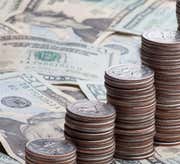As the name implies, income investors try to generate a steady income out of their investments. While fixed-income securities such as bonds and CDs have been popular with income investors in the past, the low yields we’ve seen in recent years have made it difficult to generate meaningful returns. Fortunately, there are plenty of dividend-paying stocks that can be used to generate a steady income stream.
Who Pays Dividends?
Not all companies pay a dividend. If a company has earned a profit, it has some options when it comes to using that money. Companies that earn a profit can:
-
Reinvest their profits through expansion, debt reduction and/or share repurchases
-
Pay a portion of their profits to shareholders through dividends
-
Both reinvest and pay out to shareholders
Younger companies in rapidly expanding industries tend not to pay dividends because they want to reinvest as much money as possible into further growth – for example, they might use the money to start a new project, buy new assets, repurchase some of their shares or acquire another company.
Even stable, mature companies might avoid paying dividends if they feel they can do a better job of increasing value and share price by reinvesting earnings. Berkshire Hathaway (BRK-A, BRK-B), for example, does not pay a dividend because Warren Buffett – the company’s chairman and CEO – believes that reinvesting provides more long-term value to shareholders (the company did pay one dividend back in 1967).
Typically, dividends are paid by older, more established companies that have already reached a certain size and are no longer able to sustain higher levels of growth. These firms tend to no longer be in rapidly growing industries and – rather than reinvesting retained earnings to grow – pay out retained earnings as dividends to provide a return to shareholders.
Dividend Yield
Rather than focusing on companies with the highest dividends in terms of dollars, income investors gauge potential investments by their dividend yield. A stock’s dividend yield is the expected yearly dividend divided by the current stock price:

Let’s assume stock ABC is trading at $50 per share and the company offers an annual dividend of $5 per share. The dividend yield would be 10% ($5 dividend ÷ $50 share price = 10% dividend yield). If the stock was trading at a higher price, say $100, the dividend yield would decrease to 5% ($5 dividend ÷ $100 share price = 5% dividend yield). If, on the other hand, the stock was trading at a lower price, such as $25, the dividend yield would increase ($5 dividend ÷ $25 share price = 20% dividend yield). (Try Investopedia’s own Dividend Yield Calculator).
These figures are used to illustrate how share price affects dividend yield: keep in mind, however, that a 20% dividend yield would be highly unusual (and likely part of a very risky investment). In reality, average dividend yields are in the 2% to 5% range, depending on the sector. Income investors look for yields towards the top of that range – or above – provided the high dividend is sustainable and can produce a steady and predictable income stream over the long term. Companies that have paid steady dividends over the past five, 10, 15 or 20 years – or longer – are likely to continue that trend.
An Example
There are many good companies that pay great dividends and also grow at a respectable rate. One excellent example of this was Johnson & Johnson from 1963 to 2004. In those years, Johnson & Johnson increased its dividend every year. In fact, if you had bought the stock in 1963 the dividend yield on your initial shares would have grown approximately 12% annually. Thirty years later, your earnings from dividends alone would have rendered a 48% annual return on your initial shares!
Here is a chart of Johnson & Johnson's share price (adjusted for splits and dividend payments), which demonstrates the power of the combination of dividend yield and company appreciation:
 |
This chart should address the concerns of those who simply dismiss income investing as an extremely defensive and conservative investment style. When an initial investment appreciates over 225 times - including dividends - in about 20 years, that may be about as "sexy" as it gets.
Finding good income investing stocks – ones that pay a good dividend and that are expected to continue doing so – takes significant research. You can start by using a stock screener to find companies paying the highest dividend yields, and then analyze them using fundamental analysis – and your own interpretation of the numbers.
Dividends Are Not Everything
You should never invest solely on the basis of dividends. Keep in mind that high dividends don't automatically indicate a good company. Because they are paid out of a company's net income, higher dividends will result in a lower retained earnings. Problems arise when the income that would have been better re-invested into the company goes to high dividends instead.
The income investing strategy is about more than using a stock screener to find the companies with the highest dividend yield. Because these yields are only worth something if they are sustainable, income investors must be sure to analyze their companies carefully, buying only ones that have good fundamentals. Like all other strategies discussed in this tutorial, the income investing strategy has no set formula for finding a good company. To determine the sustainability of dividends by means of fundamental analysis, each individual investor must use his or her own interpretive skills and personal judgment – for this reason, we won't get into what defines a "good company".
Stock Picking, not Fixed Income
Something to remember is that dividends do not equal lower risk. The risk associated with any equity security still applies to those with high dividend yields, although the risk can be minimized by picking solid companies.
Taxes Taxes Taxes
One final important note: in most countries and states/provinces, dividend payments are taxed at the same rate as your wages. As such, these payments tend to be taxed higher than capital gains, which is a factor that reduces your overall return.
Stock-Picking Strategies: CAN SLIM
-
 Investing
InvestingIs Dividend Investing a Good Strategy?
Understanding dividends and how they generate steady income for shareholders will help you become a more informed and successful investor. -
 Investing
InvestingPut Dividends to Work in Your Portfolio
Find out how a company can put its profits directly into your hands. -
 Investing
InvestingDividend Yield For The Downturn
High-dividend stocks make excellent bear market investments, but the payouts aren't a sure thing. -
 Investing
InvestingThe Top 5 Dividend Paying Oil Stocks for 2016
Discover the top five dividend-paying oil companies for 2016 and what factors contribute to their ability to continue dividend payments. -
 Financial Advisor
Financial AdvisorHow mutual funds pay dividends: An overview
The process by which mutual fund dividends are calculated, distributed and reported is fairly straightforward in most cases. Here's a look. -
 Retirement
RetirementHow Reinvesting Dividends Pays in the Long Run
Dividend reinvestment is one of the easiest ways to grow wealth and can increase your investment income over time. -
 Investing
InvestingThe Best 8 Funds For Regular Dividend Income
Here's a list of the top mutual funds which pay regular dividends, for frequent income. -
 Investing
InvestingIntroduction To Dividends
Investing in dividend-paying stocks can be an effective method of building long-term wealth.



